Railroad Access and Hampton Roads Shipping Terminals
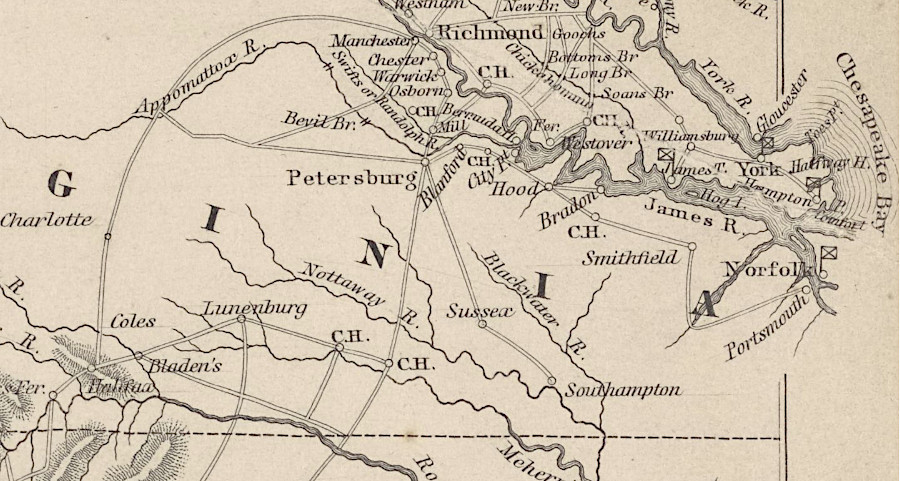
there was one road connecting Norfolk and Portsmouth to the rest of Virginia at the start of the Revolutionary War
Source: New York Public Library, Map of part of Virginia, North Carolina, South Carolina, & Georgia: which were the scenes of the most important operations of the southern armies
At the time of the Revolutionary War, Portsmouth and Norfolk were easily accessible by water but hard to reach by land. One road connected Suffolk to the Elizabeth River. Lord Dunmore fled Williamsburg on June 8, 1775 and used Norfolk as his base. The British sought to block the American rebels from attacking Norfolk by building a fort on the road at Great Bridge. The Americans seized control of the bridge, and after losing control of the road the British abandoned Norfolk.
Prior to the Civil War, the Dismal Swamp Canal and the Albemarle and Chesapeake Canal allowed boats to get from the Roanoke River and the Chowan River to Norfolk. They have remained in business due to Federal government subsidies, but after the Civil War railroads replaced them for transport of freight. The canals today serve recreational boaters almost exclusively.
By 1858, two railroads provided connections from the Fall Line to ports at Hampton Roads. The Seaboard and Roanoke Railroad connected the Roanoke River at Weldon to a terminal at Portsmouth. The Norfolk and Petersburg Railroad linked the Appomattox River at Petersburg to a terminal in Norfolk.
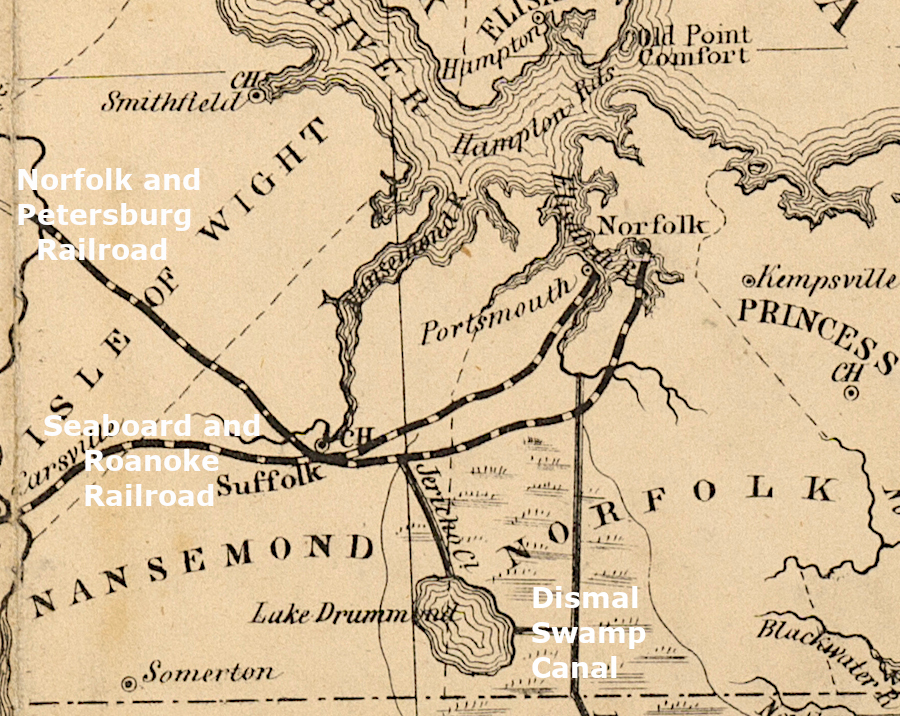
in 1858, both Portsmouth and Norfolk were connected by railroads to the Fall Line
Source: Library of Virginia, A map of the rail roads of Virginia
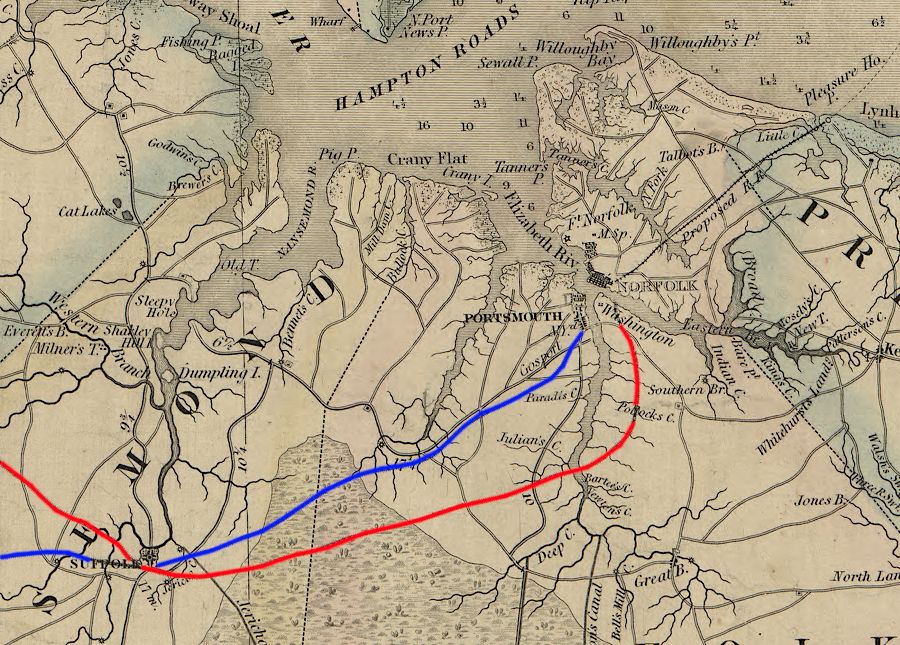
in 1859 the Seaboard and Roanoke Railroad (blue) served Portsmouth, and the Norfolk and Petersburg Railroad (red) served Norfolk
Source: Library of Congress, A map of the state of Virginia (by Lewis Von Buchholtz, L. V., Herman Böÿe, Benjamin Tanner, 1859)
By 1906, multiple railroads connected Portsmouth and Norfolk to the hinterland in the Coastal Plain and far beyond, into the Piedmont and Appalachian Plateau coal fields.
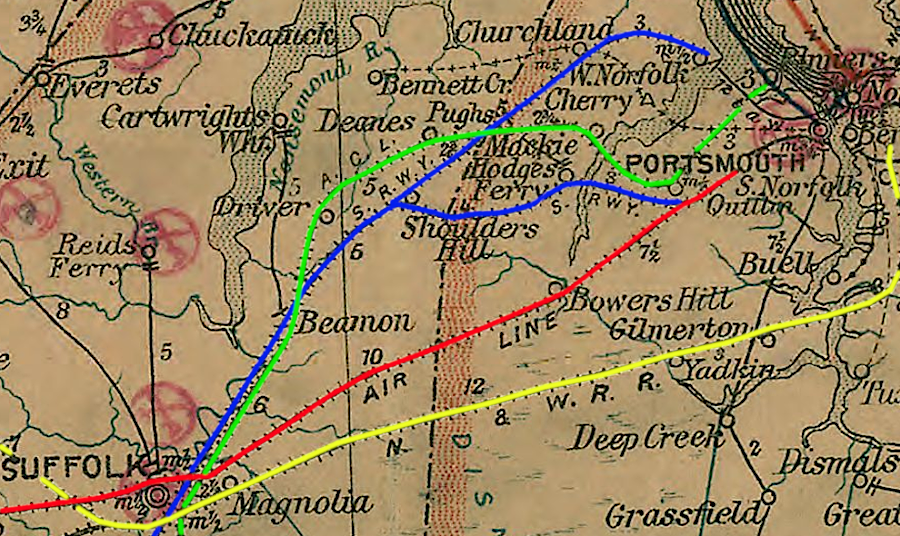
in 1906: green=the Western Branch Railway/Norfolk & Carolina Railroad/Atlantic Coast Line, yellow=Norfolk and Petersburg/Norfolk and Western, blue=Atlantic and Danville/Southern Railway, red=Portsmouth and Roanoke/Seaboard and Roanoke/Seaboard Air Line
Source: Library of Congress, Post route map of the states of Virginia and West Virginia (1906)

three railroads linked directly to Norfolk in 1896 (yellow=Norfolk and Western, red=original Norfolk Southern, blue=Norfolk, Virginia Beach & Southern Railroad
Source: Library of Congress, Post route map of the state of Virginia and West Virginia (1896)
The Portsmouth and Roanoke Railroad (red line, above) built the first track to bring freight and passengers to Portsmouth, extending the Western Branch Railway from Drivers. It connected to the Roanoke River at Weldon in 1837. Tobacco and other products being floated down the river no longer had to take the slower route via the Dismal Swamp Canal, and had an alternative to the Petersburg Railroad connection which had reached Weldon in 1933. In fierce competition between the two railroads, the Portsmouth and Roanoke Railroad was forced into bankruptcy. It was reorganized in 1846 as the Seaboard and Roanoke Railroad, and in 1900 was formally merged into the Seaboard Air Line.
The Norfolk and Petersburg Railroad (yellow line, above) was completed in 1858, after overcoming resistance by Petersburg and Richmond business leaders to getting a charter and financing. it became part of the Atlantic, Mississippi and Ohio Railroad after the Civil War, and in 1881 was incorporated into the Norfolk and Western Railroad.
In 1890, the Norfolk & Carolina Railroad (green line, above) connected the interior of North Carolina via Tarboro, rather than Weldon, to shipping piers at Pinners Point on the Elizabeth River. Similarly, the Suffolk & Carolina Railway (purple line, above) brought wood from Carolina's Coastal Plain to Suffolk's mills and other agricultural products to Chesapeake Bay ports.
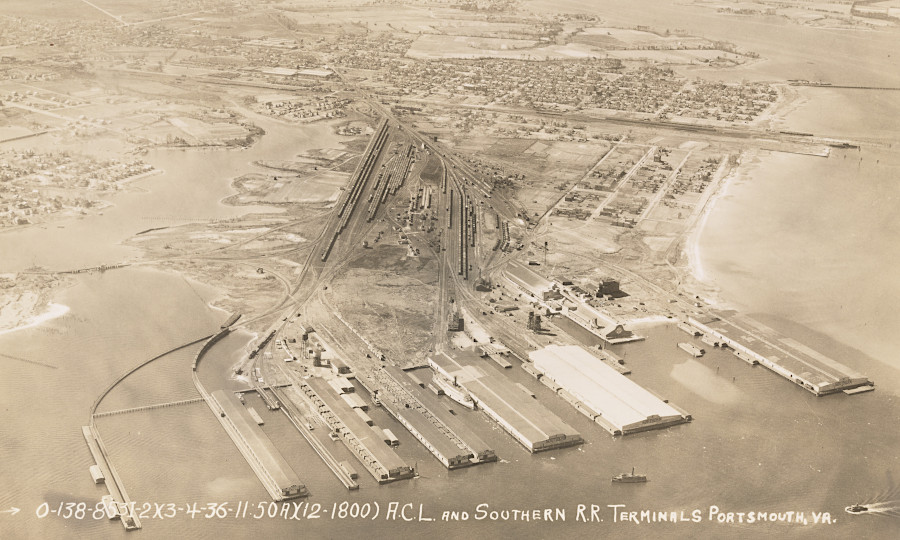
terminal at Pinners Point in the 1930's
Source: National Archives, Virginia - Portsmouth
The Atlantic and Danville Railroad (blue line, above) intercepted the Roanoke River trade much further upstream from Weldon. It paralleled the Virginia-Carolina border west to Emporia and ultimately reached Danville in 1891. After going through bankruptcy in 1894 and being renamed the Atlantic and Danville Railway, it was leased by the Southern Railway in 1899.
Passenger traffic was significant, in addition to freight. Two rail lines carried tourists from Norfolk to resort areas. The Norfolk and Ocean View Railroad (brown line, above) took vacationers north to Ocean View on Willoughby Spit, on the shoreline of the Chesapeake Bay. The Norfolk Southern Railroad (light blue line, above) carried vacationers due east to the Virginia Beach resort area on the Atlantic Ocean, while other track brought agricultural products from North Carolina into Norfolk.
In 1895, Norfolk and Portsmouth were major transportation centers due to railroads, canals, and shipping terminals on the Elizabeth River.
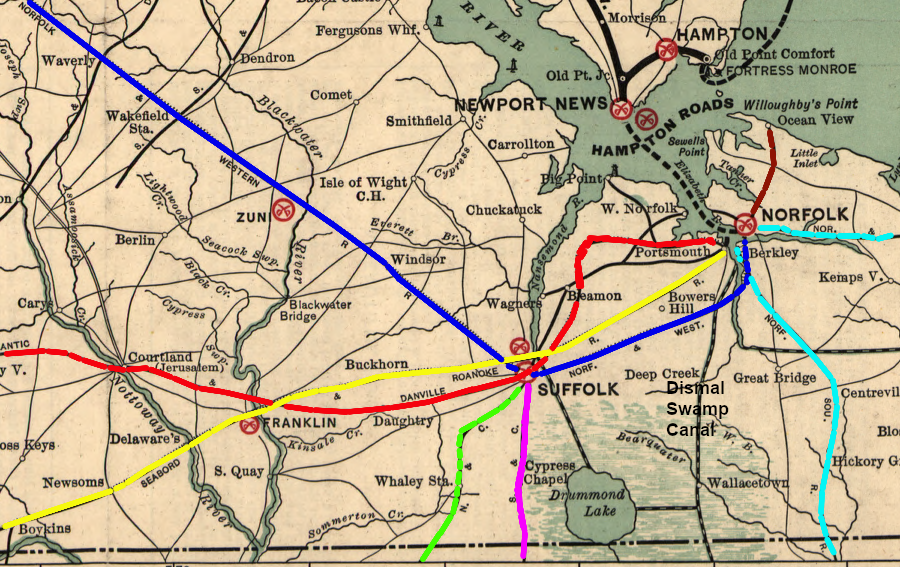
in 1895, Norfolk and Portsmouth were major transportation centers due to railroads, canals, and shipping terminals on the Elizabeth River
Source: Library of Congress, Map showing the location of battle fields of Virginia (Chesapeake and Ohio Railway Company, 1895)
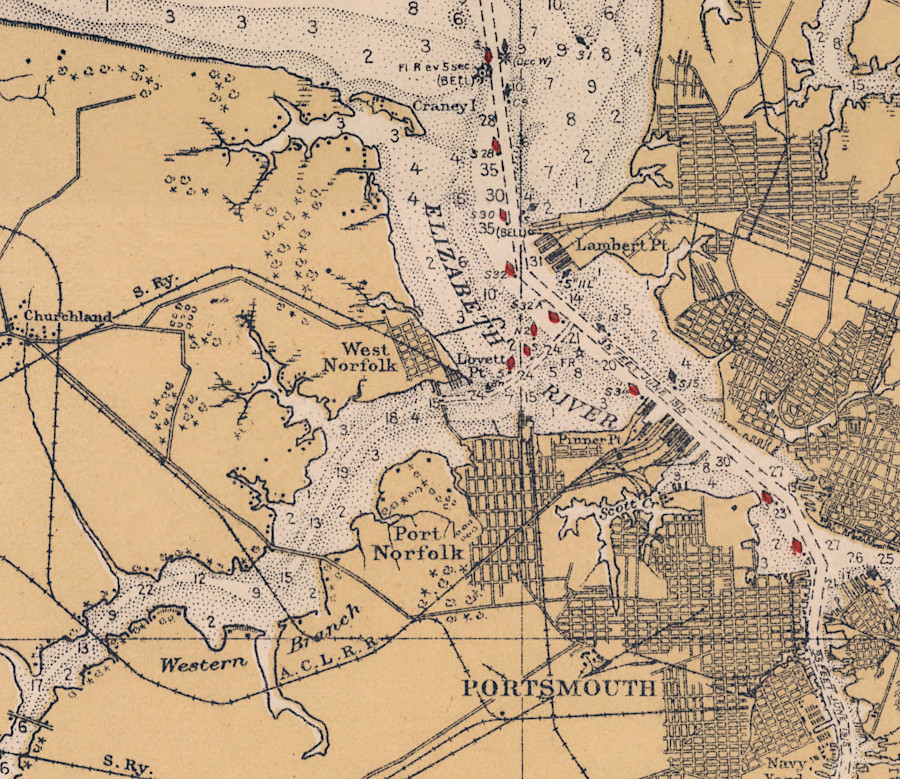
multiple railroads built piers and wharves along the Elizabeth River
Source: U.S. Coast and Geodetic Survey, United States - East Coast Virginia Cape Henry to Currituck Beach Light (1916)
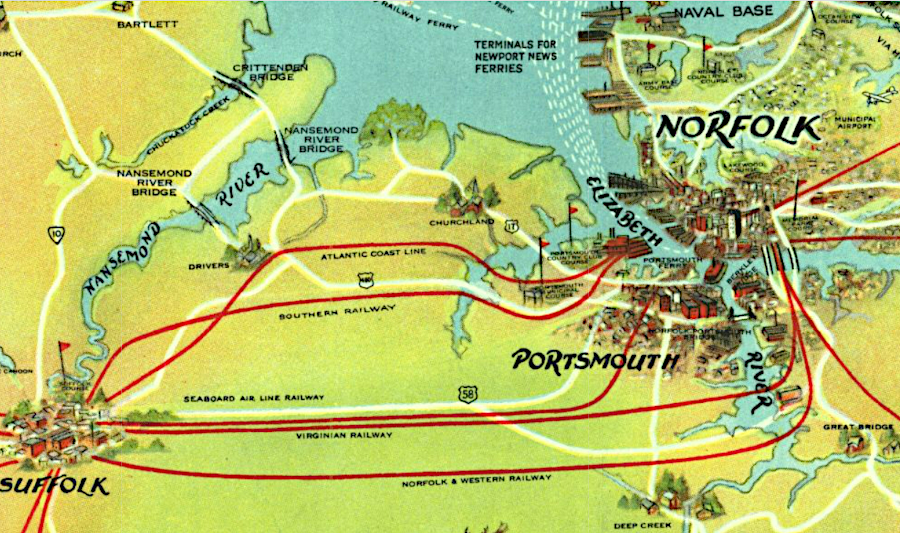
multiple railroads connected to Portsmouth in 1936
Source: Norfolk Advertising Board, Virginia Seashore (1936) (from University of Alabana Library)
Today, four railroads service the shipping terminals in Hampton Roads where cargo is loaded/unloaded from ocean-going vessels: the Norfolk Southern, CSX, Commonwealth Railway, and the Norfolk and Portsmouth Belt Line Railroad. The Buckingham Branch supports barges at Little Creek; the Chesapeake and Albemarle Railroad connects to the Norfolk Southern in the City of Chesapeake.
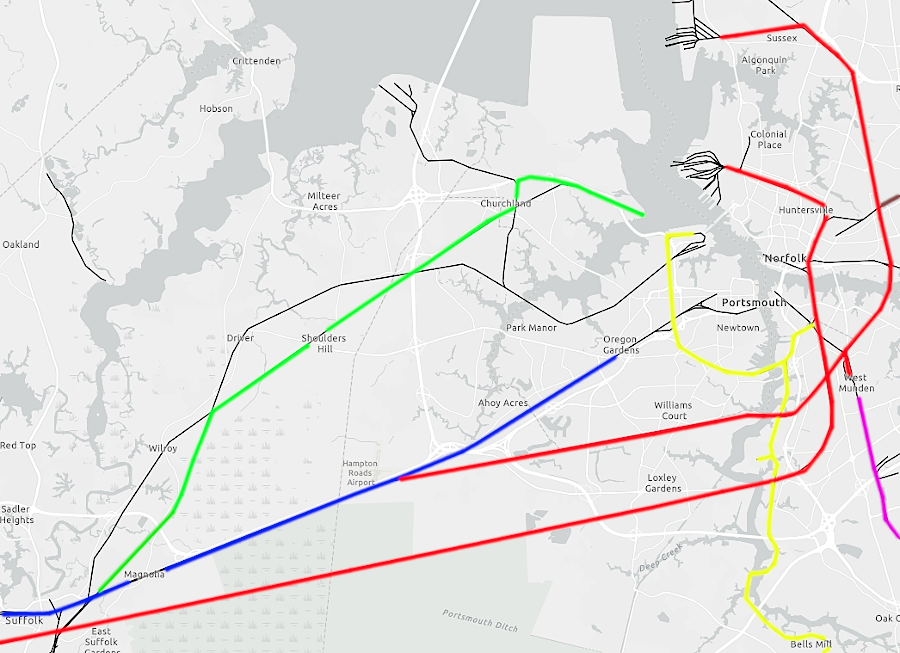
the Norfolk Southern (red), CSX (blue), Commonwealth Railway (green), Buckingham Branch (brown), Chesapeake and Albemarle (purple) and the Norfolk and Portsmouth Belt Line Railroad (yellow) are still active today
Source: Norfolk and Portsmouth Belt Line Railroad, Hampton Roads Rail Roads
The Commonwealth Railway and the Norfolk and Portsmouth Belt Line Railroad are short-lines that link Hampton Roads terminals to the long-distance Class 1 freight railroads (Norfolk Southern and the CSX) and to two other short-lines in the region (Bay Coast Railroad and the Chesapeake and Albemarle).
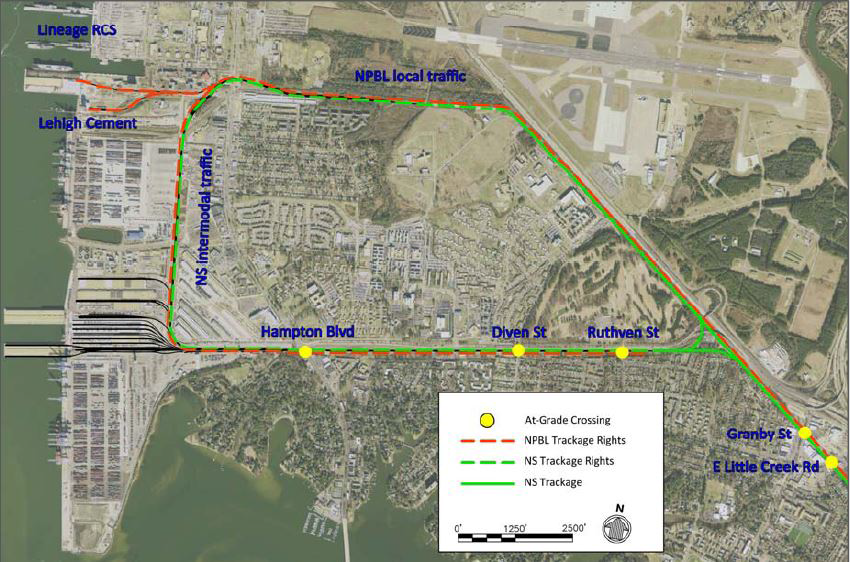
Norfolk Southern and the Norfolk and Portsmouth Belt Line provide rail access to Norfolk International Terminals (NIT)
Source: US Army Corps of Engineers, Norfolk Harbor Navigation Improvements - Draft General Reevaluation Report and Environmental Assessment (Figure 2-3)
Since the 1830's, railroad and port development have been closely intertwined. Portsmouth grew at the expense of Petersburg, after the Portsmouth and Roanoke Railroad connected the Hampton Roads port to traffic floating down the Roanoke River. The port at Newport News was spurred by the decision of the Chesapeake and Ohio Railroad to build a new line and send its coal to docks located downstream from Richmond, in order to access a deeper channel.
Virginia has sought to maximize the percentage of shipping cargo carried to/from the terminals by railroad. The Port of Virginia advertised in 2017:1
- 37 percent of cargo arrives and departs the port by rail, the largest percentage of any US East Coast port
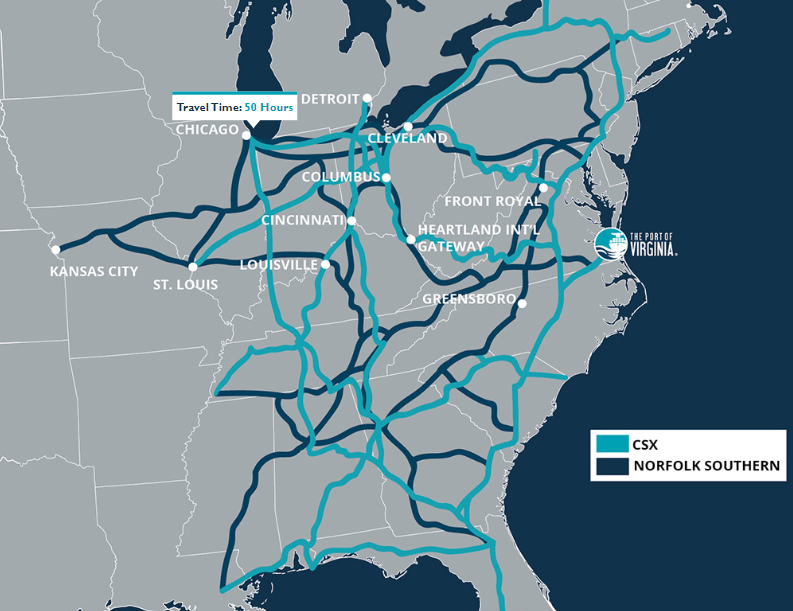
rail shipments from the Port of Virginia can reach Chicago in 50 hours
Source: Port of Virginia, Rail Map
The Commonwealth of Virginia has funded rail improvements for the state's shipping terminals, including some projects as far away as the West Virginia border, to improve service and reduce truck-related delays.
Due to decisions that date back to the 1800's, the CSX and Norfolk Southern railroads have different levels of access to different shipping terminals. Norfolk Southern has control over rail access at the Virginia Inland Port (VIP), plus a competitive advantage at Norfolk International Terminal (NIT).
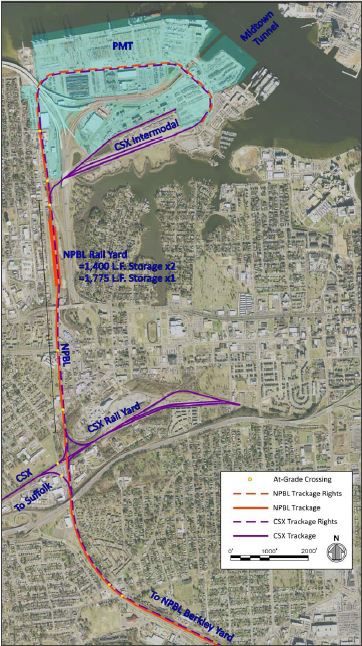
CSX and the Norfolk and Portsmouth Belt Line provide rail access to Portsmouth Marine Terminal (PMT)
Source: US Army Corps of Engineers, Norfolk Harbor Navigation Improvements - Draft General Reevaluation Report and Environmental Assessment (Figure 2-5)
CSX has control over rail access to the Newport News Marine Terminal (NNMT), plus a competitive advantage at the Portsmouth Marine Terminal (PMT) and the Richmond Marine Terminal (RMT).
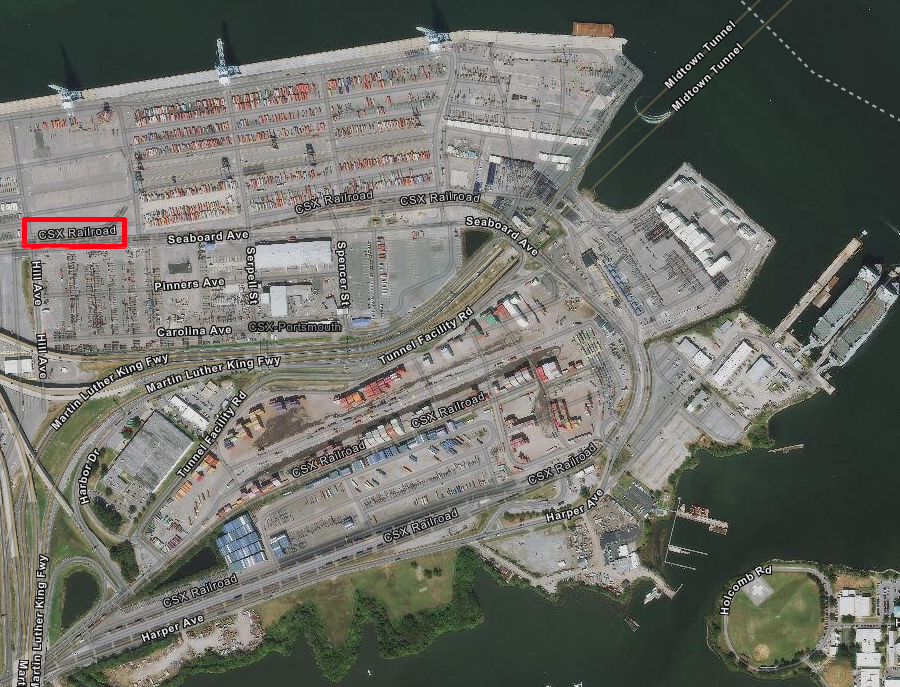
CSX acquired Seaboard Air Line, and maintains direct rail access to Portsmouth Marine Terminal (PMT) at Pinner Point
Source: ESRI, ArcGIS Online
Rail access at the Virginia International Gateway (VIG) is equitable. The Commonwealth Railway brings all loaded rail cars from the terminal to a marshalling yard in Suffolk. CSX and Norfolk Southern have equal opportunity to hook their locomotives to trains there.
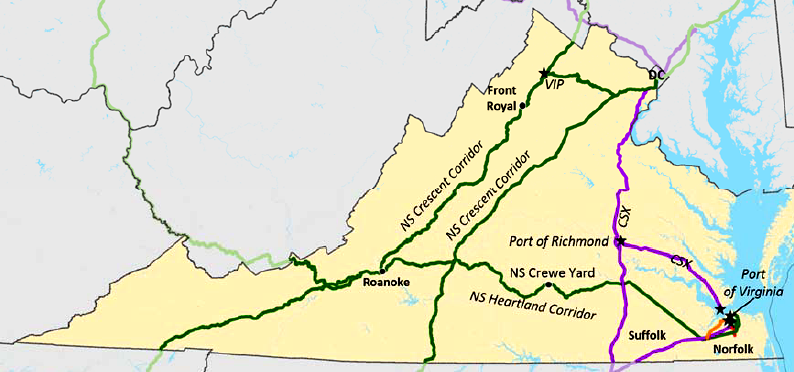
primary Virginia rail corridors for Port of Virginia cargo
Map Source: Virginia Office of Intermodal Planning and Investment, Master Rail Plan for the Port of Virginia (Figure 8)
The Heartland Corridor project enlarged Norfolk Southern tunnels through mountains in Virginia/West Virginia, facilitating traffic headed west from Norfolk and Portsmouth. Removing the physical constraints of the narrow, low tunnels enabled the Norfolk Southern "double-stack" the rail cars in Hampton Roads. Putting one container on top of another doubled the number of containers a train could carry between Norfolk and Columbus (Ohio), and to Chicago.
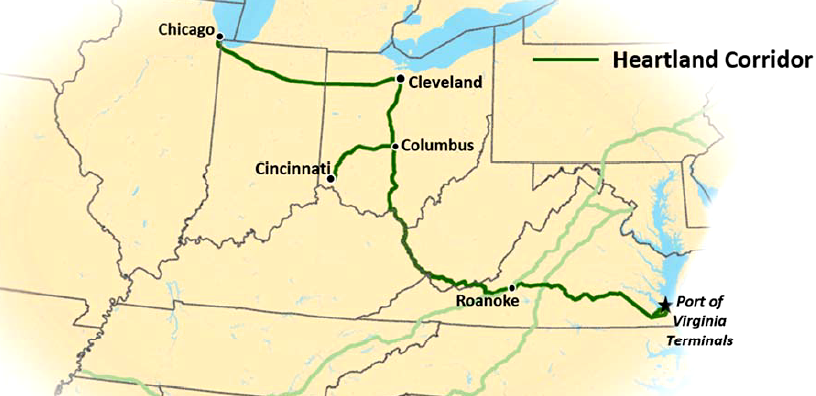
trains using Norfolk Southern's Heartland Corridor carry containers from Hampton Roads cross through the Blue Ridge at Roanoke, then go up the New River parallel to US 460 through West Virginia
Map Source: Virginia Office of Intermodal Planning and Investment, Master Rail Plan for the Port of Virginia (Figure 32)
Norfolk Southern trains can also carry cargo via the Crescent Corridor to the Virginia Inland Port and other destinations to the south in Tennessee and North Carolina.

trains going north on Norfolk Southern's Crescent Corridor carry containers from Hampton Roads through Manassas, before crossing the Blue Ridge on the "B Line" parallel to I-66
Map Source: Virginia Office of Intermodal Planning and Investment, Master Rail Plan for the Port of Virginia (Figure 32)
Government funds have also improved the CSX National Gateway, primarily to enhance north-south transport. Faster transport by rail, both at the port and inland, have made the Port of Virginia terminals more competitive against rivals at Savannah, Charleston, Baltimore, and New York/New Jersey. Virginia even contributed $24 million to upgrade the Virginia Avenue rail tunnel in Washington, DC.
The Virginia Avenue Tunnel in the District of Columbia, a four-year project started in 2015, added a second track and made it possible for double-stacked trains to get through that former bottleneck. Widening the Long Bridge railroad crossing over the Potomac River from two to four tracks, a project not yet funded, will allow CSX to bid even more competitively to haul containerized cargo to/from the Port of Virginia.2
The CSX National Gateway project, including the Kilby Rail Yard in Suffolk, also enhanced access to Virginia's ports. CSX stopped offering intermodal service to the Newport News Marine Terminal (NNMT) at the end of 1988. Twenty years later the railroad refocused on Hampton Roads, after the APM/Maersk terminal (now Virginia International Gateway) was completed and container operations moved there from the Portsmouth Marine Terminal (PMT).
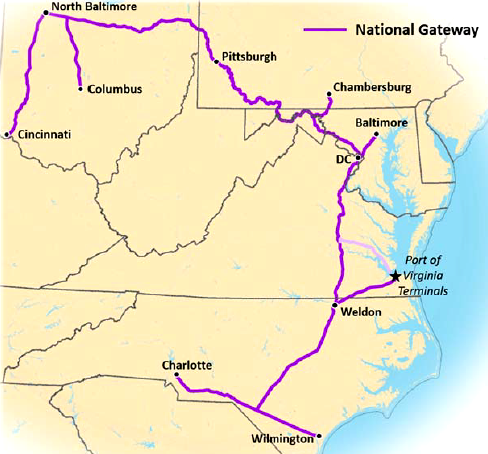
upgrading the CSX National Gateway including improving the Virginia Avenue Tunnel in Washington, DC so it could accommodate rail cars with double-stacked containers
Map Source: Virginia Office of Intermodal Planning and Investment, Master Rail Plan for the Port of Virginia (Figure 30)
Shippers using Virginia Port Authority terminals benefit from rail competition. Since 2012, both CSX and Norfolk Southern (NS) have been able to build trains at Virginia International Gateway (VIG) without the expense of drayage to an off-site rail yard. However:3
- ...the schedule for CSX trains at VIG is compressed by the national and regional schedules for passenger trains and to a lesser degree freight trains due to the mainline track capacity shortages between Richmond and Fredericksburg.
- The Port and CBP [Customs and Border Protection] have limited resources to support this schedule, resulting in reduced level of Port and CBP service for CSX cargo.
- ...At NIT [Norfolk International Terminal], NS enjoys a competitive advantage as it owns a rail line leading directly into the NIT complex. CSX accesses NIT utilizing the Norfolk and Portsmouth Belt Line Railroad (NPBL), which was formed over 100 years ago by the Class I railroads (of which, NS and CSX are the sole remaining shareholders) to improve level of service to rail-served industries in Hampton Roads. This introduces additional rail operations for CSX to access the terminal. NS's advantage has thus far limited CSX rail demand at NIT to relatively low volume project, bulk, and break-bulk cargo.
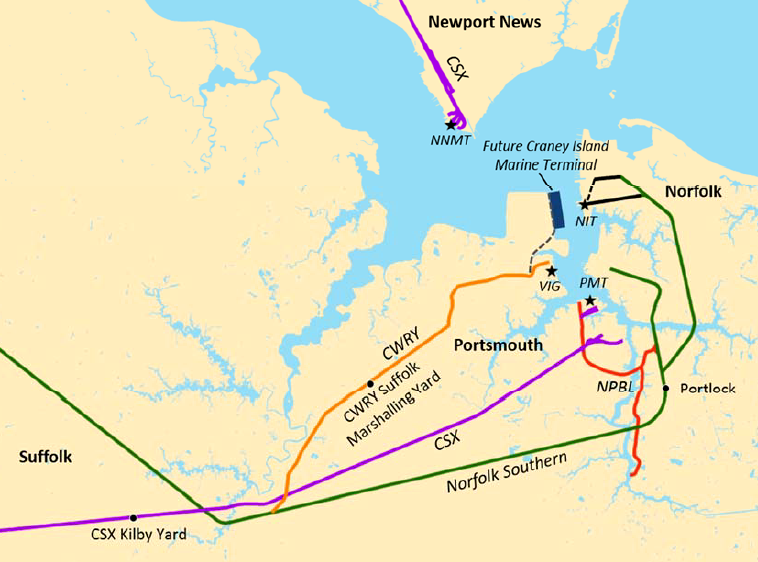
the short-line Commonwealth Railway (CWRY) and Norfolk and Portsmouth Belt Line (NPBL) ensure shippers using Port of Virginia terminals have access to both CSX and Norfolk Southern railroads
Map Source: Virginia Office of Intermodal Planning and Investment, Master Rail Plan for the Port of Virginia (Figure 7)
Shippers are attracted to ports that offer competition between railroads, allowing for negotiations to improve service and reduce costs. Until the Staggers Rail Act of 1980 deregulated railroads and allowed competition, rates were based on distance. Shippers in the industrial Midwest sent most traffic to Baltimore, because it involved less distance than Hampton Roads.
Virginia competed for traffic by opening the Virginia Inland Port in 1989, and shippers began sending their goods to Front Royal for later loading at Hampton Roads ports. The Virginia Port Authority competes on service as well as price. Having a deep shipping channel is a competitive advantage. In addition, Hampton Roads ports are closer to the Atlantic Ocean than Baltimore. Ships stopping in Virginia save a day by avoiding most of the Chesapeake Bay.
Just one private company is responsible for loading and unloading cargo:4
- CP&O, a joint partnership between The Cooper Group, Ports America and Ceres Marine Terminals, provides stevedoring and terminal services at all major terminal facilities in the Port of Hampton Roads. These facilities include the three marine terminals operated by Virginia International Terminals in Norfolk, Portsmouth and Newport News. At Lambert's Point Docks, owned by Norfolk Southern Railroad, CP&O handles break bulk and project cargo. In addition to container and break bulk cargo, CP&O also handles automobiles at Newport News. Cruise vessels calling at Hampton Roads are serviced by CP&O at the Half Moon Cruise Terminal. CP&O provides all baggage handling and ship provision loading services.
Shippers can choose the railroad they wish to use, as well as the ultimate port. The Maersk Line shifted its business from Norfolk Southern to CSX in 2012 and started to ship containers to the CSX Intermodal North Baltimore terminal near Toledo, Ohio.
"Fair access" to the Port of Virginia terminals may not be in the interest of competing railroads. As a result of railroad mergers, Norfolk Southern ended up in control of the Norfolk and Portsmouth Belt Line Railroad. One clue to the dominance of that railroad: the Belt Line managers used Norfolk Southern email addresses and did not use the "@npblrr.com" domain.
The trains assembled and hauled by the Norfolk and Portsmouth Belt Line Railroad had to use Norfolk Southern tracks to access the Norfolk International Terminals (NIT). In 2018, CSX sued Norfolk Southern and the Norfolk & Portsmouth Belt Line Railroad, claiming its traffic was delayed unfairly and charged excessive rates by the Norfolk & Portsmouth Belt Line Railroad:5
- NS and the NPBL have used the NPBL as a chess piece to establish and maintain NS's monopolistic control over intermodal transportation in and out of NIT (Norfolk International Terminals) by making it practically impossible for any other rail carriers to provide intermodal service to NIT

if rail costs are high due to limited competition, shippers using trucks as the alternative have to fight Norfolk/Portsmouth traffic bottlenecks such as the Midtown Tunnel
Source: Virginia Department of Transportation, Midtown Tunnel, under the Elizabeth River, Rt. 58. Portsmouth side
The ports at Savannah, Baltimore, and New Jersey/New York are close to major metropolitan centers. Hampton Roads offers less of a local market for shippers, so the Port of Virginia emphasizes in its marketing how rail connections provide access to customers in Ohio, Illinois and the rest of the Midwest. Port officials made clear in 2016 that the growth in demand would continue to be rail shipments to the Mississippi River watershed:6
- Our growth area is really in the Midwest... The rail hubs in Ohio and even to Memphis and Chicago and St. Louis - we've got the rail access to service that market.
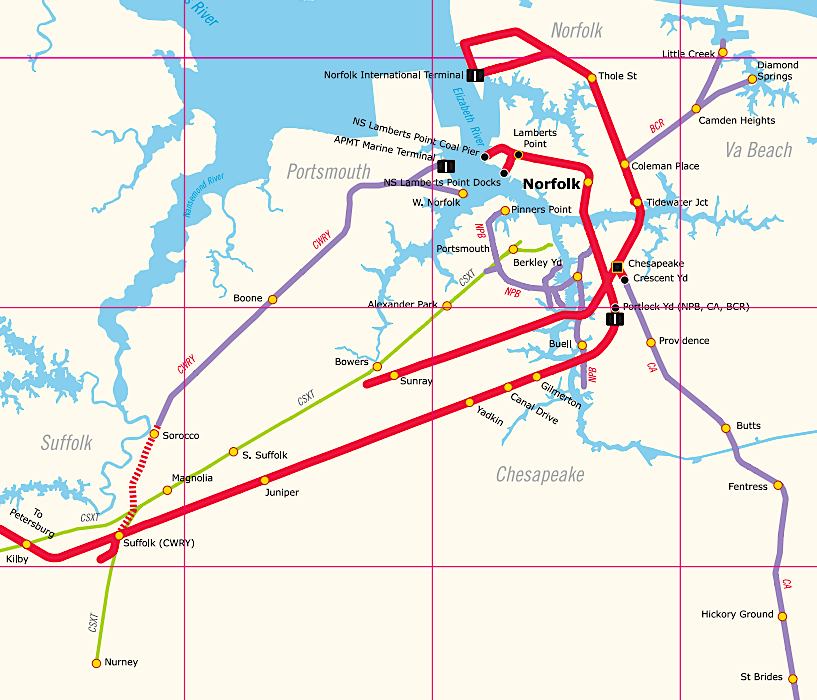
in 2016, the Bay Coast Railroad (BCR) still served Virginia Beach/Norfolk
Source: Norfolk Southern, Norfolk Southern System Map (2016)
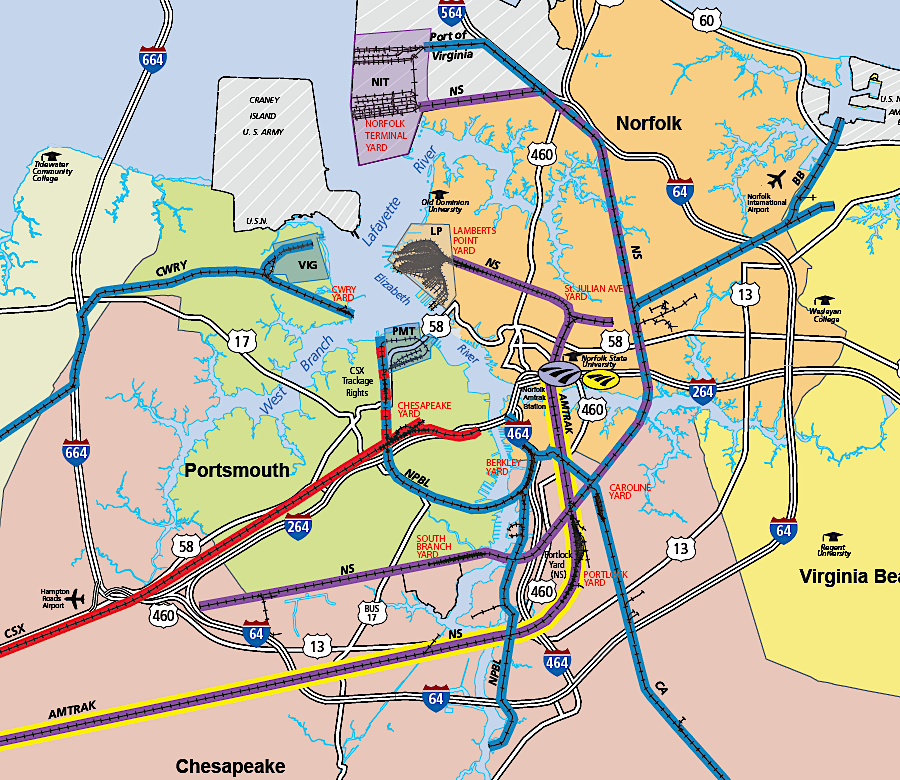
in 2019, Hampton Roads terminals were served by CSX. Norfolk Southern, and four short line railroads
Source: Virginia Department of Rail and Public Transportation, Virginia State Railroad Map (2019)
A $20 million Federal grant in 2020 helped fund an $83 million rail yard expansion of the Central Rail Yard at Norfolk International Terminal (NIT). The project added two new bundles of four tracks plus loading space. The project increased rail capacity by 35% and enabled initiation of new service to Memphis, Tennessee. Port officials said their goal was to have 40% of containers moved by rail.7

Virginia's ports offer better rail connections and greater intermodal transport than competing ports in other states ("TEU" = "twenty-foot equivalent units," half the length of trailers commonly loaded on rail cars now)
Map Source: Virginia Office of Intermodal Planning and Investment, Master Rail Plan for the Port of Virginia (Table 1)
The Port of Baltimore was closed to ship traffic after the collapse of the I-695 (Francis Scott Key) bridge in 2024. CSX rerouted trains of cargo to the Port of New York and New Jersey, rather than to the Port of Virginia. That decision reflected in part the origin of the cargo; the port north of Baltimore was closer than Hampton Roads. It also reflected CSX's limited capacity to use the terminal at Newport News, which that railroad supplied, for containerized cargo,
Two thirds of Baltimore's container business and one third of its automobile import/export shipments were re-routed to the Port of New York and New Jersey. Cars imported into Newark were then transported to the processing facilities in Baltimore in order to keep the labor force there from dissipating before the port reopened. Other vehicle shipments, including farm tractors, were redirected to Brunswick, Georgia as well as Newport News Marine Terminal (NNMT). Both ports had the equipment required for loading/unloading vehicles, including tow hitches and wheel locks.
All Appalachian coal shipments from Baltimore were blocked. Norfolk Southern trains carried extra coal to Lamberts Point, that railroad's export terminal in Norfolk, so foreign steel plants could continue to receive metallurgical coal. As advertised by the company:8
- Lamberts Point Coal Terminal is the largest, fastest, and most efficient transloading facility for coal in the Northern Hemisphere. Opened on the Elizabeth River around 1865, the NS-served and operated transshipment terminal boasts an annual throughput capacity of 48 million tons...
- At the heart of the terminal is the 1,850-foot-long Pier 6, in use since 1962. Operated 24/7, the pier features two 18-story-tall ship loaders that enable the facility to load two vessels simultaneously. Twin tandem rotary dumpers tip over railcars brimming with 100 tons of coal, feeding the ship loaders for a combined loading capacity of up to 8,000 tons per hour...
- A special competitive advantage is the terminal's ability to offer complete coal blending and mixing services for both metallurgical and utility coal applications. A four-stage sampling system, operated independently by Sampling Associates International, can provide ASTM- ISO-approved samples for all cargoes.
Volume increased as much as 35%. Rotary dumpers at both loaders were kept busy turning loaded coal cars completely upside down, in order to pour coal into shiploaders that dropped the preferred mixtures of coal into freighters. The superintendent of terminals for the Norfolk Southern said:9
- The old hands, last year, when the volumes weren't as big, would try to old school you and tell you about the glory days... Well, we're kind of feeling them again right now.
Between 2020-2025, cargo traffic in Norfolk's ports grew by 30%. During that time 7% of traffic switched from trucks to rail. One impact of additional trains and longer trains was an increase of traffic delays; vehicles had to wait longer at the 307 public, at-grade railroad crossings in Hampton Roads. In an effort to obtain Federal funding to reduce the delays, the Hampton Roads Transportation Planning Organization prioritized the crossings. On a 100-point scale, they were ranked according to six criteria:10
25 points - estimated delay
20 points - safety
15 points - traffic volumes
15 points - - roadway characteristics
15 points - area-equity factors
10 points - train volumes
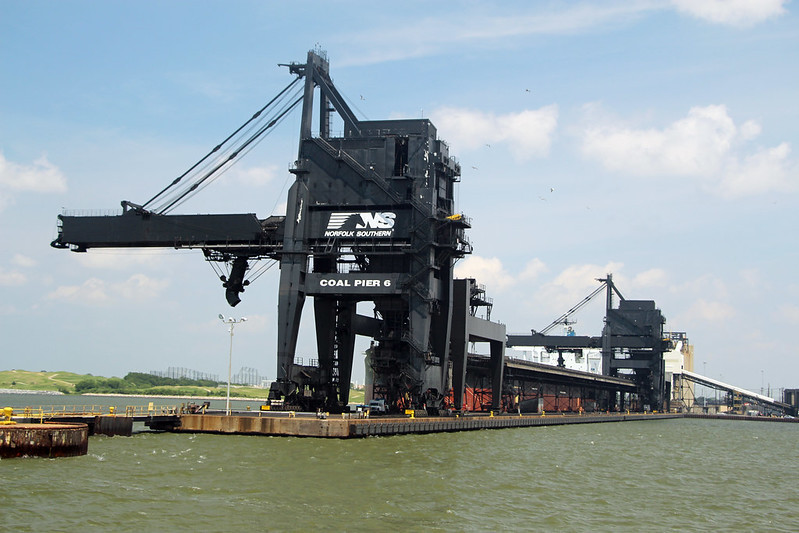
coal shipments at Lamberts Point increased when the Port of Baltimore was closed in 2024
Source: chesapeakeclimate, Lamberts Point Coal Terminal - Norfolk Southern
Links
References
1. "Fast Facts," Port of Virginia, http://www.portofvirginia.com/about/fast-facts/ (last checked November 12, 2017)
2. "Virginia Avenue Tunnel Fact Sheet," CSX, http://www.virginiaavenuetunnel.com/sites/default/files/CSX%20VAT%20Fact%20Sheet_2-17.pdf (last checked November 13, 2017)
3. "Master Rail Plan for the Port of Virginia," Virginia Office of Intermodal Planning and Investment, April 16, 2015, p.ES-4, p.ES-6, http://www.vtrans.org/resources/150416_FINAL_Master_Rail_Plan_for_the_Port_of_Virginia-cvr.pdf (last checked August 5, 2016)
4. "Port War Takes Turn," Daily Press, March 5, 1990, https://www.dailypress.com/news/dp-xpm-19900305-1990-03-05-9002280123-story.html; "About CP&O," CP&O, https://www.cpando.com/about (last checked April 24, 2024)
5. "Kilby Yard," National Gateway Project, http://www.nationalgateway.org/projects/project/548; "CSX CEO Michael J. Ward Remarks to Virginia Port Authority Board of Commissioners," "Terminal Gets $26 Million Facelift," Daily Press (Newport News), January 9, 1989, http://articles.dailypress.com/1989-01-09/business/8901100086_1_steel-imports-virginia-port-authority-virginia-international-terminals/2; Port of Virginia, September 25, 2012, http://www.portofvirginia.com/media/84950/csx_ceo_michael_j_ward_remarks_vpa_092512.pdf; "CSX to start on-dock rail service at APM on Jan. 3," The Virginian-Pilot, December 21, 2011, http://hamptonroads.com/2011/12/csx-start-ondock-rail-service-apm-jan-3; "It takes a village, but today intermodal railroad service is expanding," American Journal of Transportation, September 20, 2012, http://www.ajot.com/article_SpecialFeatures.asp?ArticleId=15653; "CSX sues Norfolk Southern and short-line railroad, alleging monopoly at biggest port terminal," The Virginian-Pilot, October 8, 2018, https://pilotonline.com/business/ports-rail/article_af3f1988-cb1e-11e8-8f3f-8b53193a4289.html (last checked October 28, 2018)
6. "Virginia Port Authority floats ambitious plan for future," Daily Press, November 15, 2016, http://www.dailypress.com/business/newport-news-shipyard/dp-nws-port-expansion-1116----representatives-of-the-virginia-port-authority-vis-20161115-story.html; "Rail: a key to the port's competitiveness," Virginia Business, April 12, 2018, http://www.virginiabusiness.com/reports/article/rail-a-key-to-the-ports-competitiveness (last checked April 23, 2018)
7. "Port of Virginia gets $20 million federal grant for rail yard expansion," The Virginian-Pilot, October 15, 2020, https://www.pilotonline.com/inside-business/vp-ib-port-rail-grant-1019-20201015-r2ktasectbcvzo5paaxru2n3ge-story.html; "Norfolk International Terminals rail upgrades on track for 2024 completion," The Virginian-Pilot, March 28, 2023, https://www.pilotonline.com/inside-business/vp-nw-port-rail-upgrades-0329-20230328-krpmdifycvdchllzww7fy4ontu-story.html (last checked October 16, 2020)
8. "Our Network Of Coal Transload Facilities," Norfolk Southern, https://www.norfolksouthern.com/en/ship-by-rail/industry/coal/coal-transload-facilities (last checked April 24, 2024)
9. "Railroad CSX adding new freight route on Tuesday to avoid Port of Baltimore after bridge collapse," WRC, April 1, 2024, https://www.nbcwashington.com/news/business/money-report/csx-starting-new-freight-rail-route-to-avoid-port-of-baltimore-closure/3580869/; "Trains, Trucks and Tractors: The Race to Reroute Goods From Baltimore," New York Times, April 17, 2024, https://www.nytimes.com/2024/04/17/business/ports-truckers-baltimore-bridge.html; "N&W's Lamberts Point pier," Endless streams and forests blog, June 7, 2010, https://streamsandforests.wordpress.com/2010/06/07/nws-lamberts-point-pier/; "Hampton Roads terminals help with thousands of diverted shipments after Baltimore bridge collapse," The Virginian-Pilot, April 24, 2024, https://www.pilotonline.com/2024/04/24/hampton-roads-terminals-help-with-thousands-of-diverted-shipments-after-baltimore-bridge-collapse/ (last checked April 24, 2024)
10. "Transportation officials seek funding to ease delays at railroad crossings in Hampton Roads," The Virginian-Pilot, January 12, 2025, https://www.pilotonline.com/2025/01/12/transportation-officials-seek-funding-to-ease-delays-at-railroad-crossings-in-hampton-roads/ (last checked January 13, 2025)
Railroads of Virginia
From Feet to Space: Transportation in Virginia
Virginia Places























